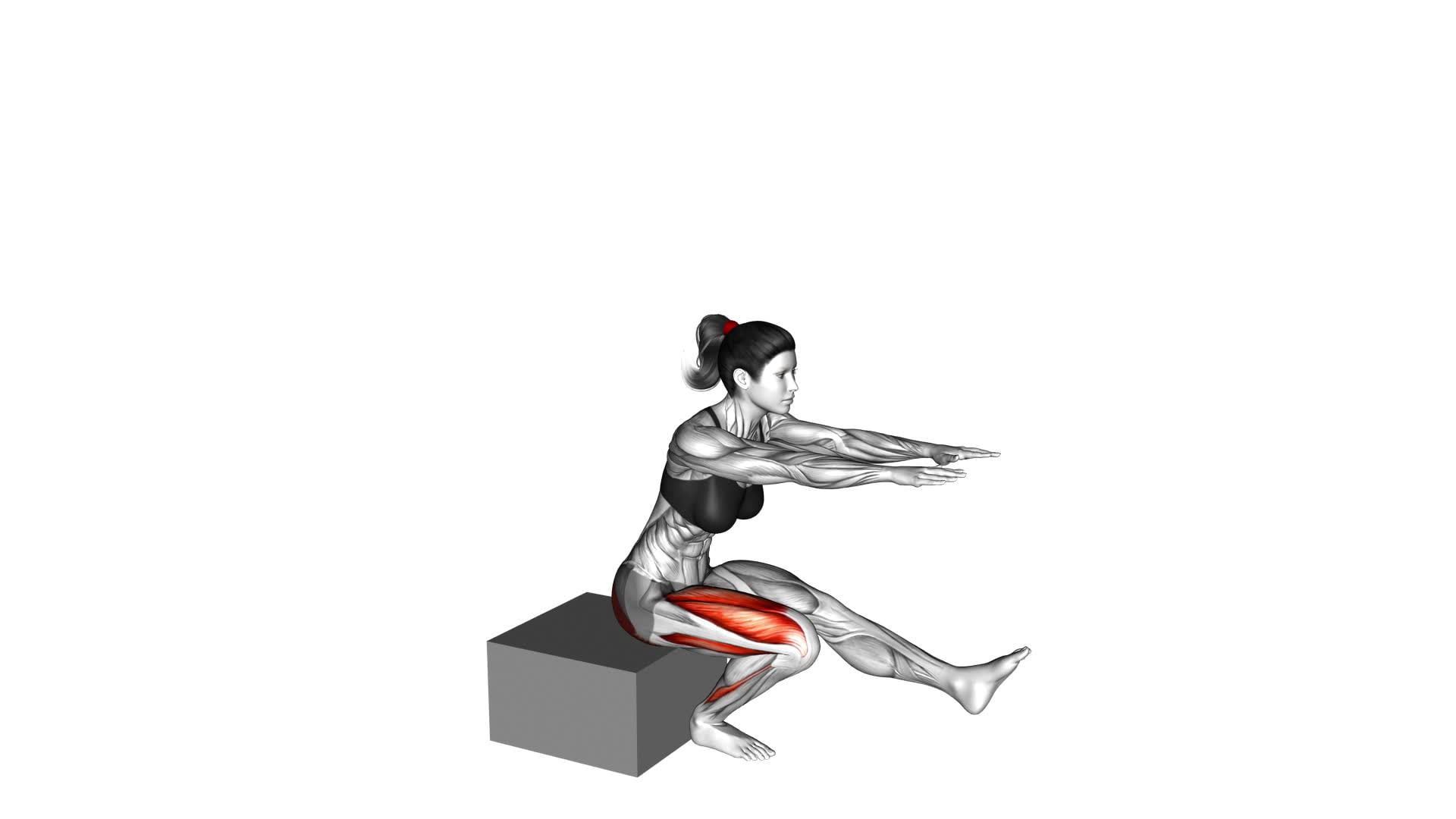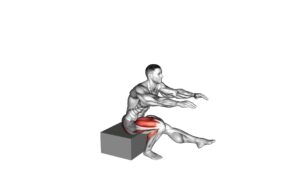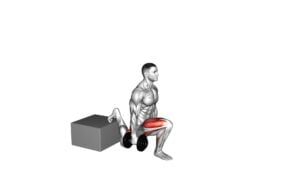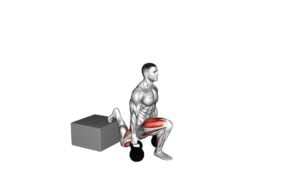Single Leg Low Box Squat (female) – Video Exercise Guide & Tips

Are you looking to strengthen your lower body and improve your balance?
Watch This Exercise Video
The Single Leg Low Box Squat is a great exercise for you! In this video exercise guide, we'll show you the proper form and technique, along with helpful tips to maximize your results.
Whether you're a beginner or more advanced, this exercise can be modified to suit your fitness level.
Get ready to feel the burn and see the benefits!
Key Takeaways
- Single Leg Low Box Squat improves lower body strength and stability.
- It activates smaller stabilizer muscles in the legs and core.
- This exercise enhances proprioception and coordination.
- It corrects muscular imbalances and ensures equal strength and functionality in both legs.
Benefits of the Single Leg Low Box Squat
Improve your lower body strength and stability with the Single Leg Low Box Squat. Incorporating single leg exercises into your workout routine offers numerous benefits.
First and foremost, these exercises help to improve your balance and stability by activating the smaller stabilizer muscles in your legs and core. By challenging your balance, single leg exercises also help to enhance proprioception, which is your body's awareness of where it's in space. This can be particularly beneficial for athletes or anyone looking to improve their overall coordination.
In addition, single leg exercises like the Single Leg Low Box Squat can help to correct muscular imbalances. Many people have one leg that's stronger or more dominant than the other, which can lead to compensations and potential injuries. By isolating each leg, you can identify and address any imbalances, ensuring that both sides of your body are equally strong and functional.
Proper form is crucial when performing squats, especially single leg squats. To maintain proper form, start by standing in front of a low box or bench. Lift one leg slightly off the ground and slowly lower yourself down onto the box, keeping your standing knee in line with your toes. Focus on keeping your core engaged and your chest lifted throughout the movement. Push through your heel to stand back up, maintaining control and balance. Repeat on the other leg.
Incorporating single leg exercises like the Single Leg Low Box Squat into your workout routine can help to improve your lower body strength, stability, balance, and overall coordination. By addressing any muscular imbalances and maintaining proper form, you can reap the full benefits of this challenging exercise.
Proper Form and Technique
To perform the Single Leg Low Box Squat with proper form and technique, you should start by standing in front of a low box or bench. Follow these proper technique tips to ensure you get the most out of this exercise:
- Begin by lifting one leg off the ground and extending it forward.
- Slowly lower your body down towards the box, keeping your standing leg bent at the knee.
- Aim to lower yourself until your glutes touch the box, then pause for a moment.
- Push through your heel and engage your glutes and quadriceps to return to the starting position.
- Keep your core engaged throughout the movement to maintain stability and control.
It's important to be aware of common form mistakes to avoid injury and maximize the effectiveness of the exercise. Some common mistakes include:
- Allowing your knee to cave inward: Focus on keeping your knee in line with your toes throughout the movement.
- Rounding your back: Maintain a neutral spine position by keeping your chest lifted and shoulders back.
- Using excessive momentum: Perform the exercise in a controlled manner, avoiding any sudden jerky movements.
Equipment Needed for the Exercise
To properly perform the Single Leg Low Box Squat exercise, you'll need some essential equipment. These include:
- A sturdy box or bench at a low height
- Dumbbells or kettlebells for added resistance
- A mat or towel for comfort
However, if you don't have access to these items, there are alternatives you can use, such as:
- A stable chair or step
- Water bottles or cans for weight
- A folded towel or carpet for padding
Essential Equipment for Exercise
You will need a sturdy box for the Single Leg Low Box Squat exercise. This exercise helps to strengthen your lower body, particularly your quads, glutes, and hamstrings.
In addition to the box, here are five budget-friendly alternatives to traditional equipment that you can use for this exercise:
- Dumbbells or kettlebells: Hold a dumbbell or kettlebell in each hand to add resistance to the exercise.
- Resistance bands: Loop a resistance band around your thighs or ankles to provide added resistance.
- Step platform: If you don't have a box, you can use a step platform to perform the exercise.
- Stability ball: Place a stability ball between your back and a wall to support your posture during the exercise.
- Chair or bench: If you don't have access to a box or step platform, you can use a sturdy chair or bench as a substitute.
These alternatives ensure that you can still perform the Single Leg Low Box Squat exercise effectively without breaking the bank.
Alternatives to Expensive Equipment
To perform the Single Leg Low Box Squat exercise without expensive equipment, consider using cost-effective alternatives that still provide effective resistance and support.
Instead of using a specialized low box, you can use a stable chair, bench, or step platform that's at a suitable height. Make sure the alternative option is sturdy and can support your weight throughout the exercise.
Additionally, for resistance, you can use household items such as water bottles, cans, or small weights to add intensity to the exercise.
These alternative options provide a cost-effective solution for those who may not have access to or want to invest in expensive exercise equipment.
Remember to always prioritize safety and proper form when performing the Single Leg Low Box Squat exercise with alternative equipment options.
Importance of Proper Equipment
For the Single Leg Low Box Squat exercise, it's crucial to have the right equipment in order to perform the exercise safely and effectively. Here are some important safety precautions to consider when selecting the equipment for this exercise:
- Sturdy box: Use a box that's stable and can support your body weight. Make sure it's the appropriate height to allow for a proper squat position.
- Non-slip surface: Ensure that the box has a non-slip surface or place a mat or grip pad on top to prevent any slipping or sliding during the exercise.
- Proper footwear: Wear athletic shoes with good traction to provide stability and support during the exercise.
- Resistance band: Incorporate a resistance band around your thighs to engage the glute muscles and add more intensity to the exercise.
- Dumbbells: Hold dumbbells in each hand to challenge your upper body and core stability while performing the single leg low box squat.
Modifications for Beginners
Start with a higher box height to make the single leg low box squat easier. For beginners, it's important to start with modifications that allow you to build strength and balance gradually. By using a higher box, you decrease the range of motion and make the exercise more manageable.
As you progress and feel more confident, you can gradually decrease the box height to increase the challenge. This progression allows your muscles to adapt and grow stronger over time.
Another modification for beginners is to use a support or hold onto a stable object for balance. This can be a chair, wall, or even a TRX band. By having something to hold onto, you can focus on your form and stability without worrying about falling over.
Additionally, you can start by performing the exercise with both legs instead of just one. This allows you to distribute the workload evenly and build strength in both legs simultaneously.
Remember to listen to your body and take it at your own pace. It's important to start with modifications that suit your current fitness level and gradually progress as you become more comfortable and stronger.
Common Mistakes to Avoid
Avoid leaning forward during the single leg low box squat exercise. Leaning forward can put excessive strain on your lower back and compromise your form. To ensure you perform the exercise correctly and avoid common mistakes, here are some tips for improvement:
- Maintain proper alignment: Keep your chest up, shoulders back, and spine neutral throughout the movement. This will help distribute the load evenly and protect your lower back.
- Engage your core: Activate your core muscles to stabilize your body and maintain balance. This will also help prevent excessive leaning forward.
- Control your descent: Lower yourself down slowly and under control, focusing on maintaining balance and stability. This will help you avoid any sudden movements or loss of control.
- Use an appropriate box height: Start with a box height that allows you to maintain proper form. Gradually increase the height as you become more comfortable and confident with the exercise.
- Start with bodyweight only: Begin by performing the single leg low box squat without any additional weight. This will help you establish a solid foundation and ensure you have the necessary strength and stability before adding external resistance.
Tips for Maximizing Your Results
To maximize your results with the single leg low box squat, it's crucial to focus on proper form. This means maintaining a neutral spine, engaging your core, and keeping your knee aligned with your toes.
In addition, incorporating effective training strategies such as progressive overload and varying your rep ranges can help you see improvements in strength and muscle tone.
Lastly, don't forget about the importance of nutrition – fueling your body with the right nutrients will support your fitness goals and help optimize your results.
Proper Form Importance
To maximize your results, it's crucial to maintain proper form during the single leg low box squat exercise. Proper form not only helps you avoid injury but also ensures that you're effectively targeting the muscles you intend to work. Here are some benefits of proper form and common form mistakes to watch out for:
- Benefits of Proper Form:
- Increases muscle activation: Proper form allows you to engage the target muscles more effectively, leading to better results.
- Enhances stability and balance: Maintaining proper form improves your balance and stability, reducing the risk of falls or injuries.
- Promotes correct joint alignment: Proper form helps align your joints, reducing stress and potential damage to your joints.
- Prevents compensatory movements: Proper form prevents compensatory movements that may shift the focus away from the desired muscle group.
- Improves overall exercise efficiency: When you have proper form, you can perform the exercise more efficiently, maximizing the benefits in less time.
- Common Form Mistakes:
- Allowing the knee to cave inward: This can put unnecessary stress on the knee joint and decrease muscle activation.
- Rounding the back: This can lead to lower back pain and reduce the effectiveness of the exercise.
- Not reaching the desired depth: Failing to reach the appropriate depth can limit the muscle recruitment and hinder progress.
- Leaning too far forward: Leaning excessively forward can strain the lower back and shift the emphasis away from the targeted muscles.
- Using momentum: Using momentum instead of controlled movements can decrease muscle activation and limit the benefits of the exercise.
Effective Training Strategies
To maximize your results, incorporate these effective training strategies into your single leg low box squat routine.
First, vary your training methods to challenge different muscle groups and prevent plateaus. Try adding resistance bands, dumbbells, or kettlebells to increase the intensity of your workout.
Secondly, consider incorporating plyometric exercises to improve power and explosiveness. Box jumps and lateral bounds are great options for enhancing lower body strength and stability.
Additionally, make sure to include regular rest days in your workout routine to allow your muscles time to recover and repair.
Lastly, focus on proper nutrition and hydration to support your training efforts and optimize your results.
Nutrition for Optimal Results
Maximize your results by fueling your body with the right nutrition for optimal performance and recovery. Here are some tips to help you achieve your goals:
- Meal Planning: Plan your meals in advance to ensure you're eating a balanced diet. Include a variety of fruits, vegetables, lean proteins, and whole grains to provide your body with the nutrients it needs.
- Dietary Supplements: Consider incorporating dietary supplements into your routine to support your fitness goals. Consult with a healthcare professional to determine which supplements are right for you.
- Hydration: Stay hydrated throughout the day by drinking plenty of water. Hydration is essential for optimal performance and recovery.
- Timing: Eat a balanced meal or snack before and after your workouts to provide your body with the fuel it needs for exercise and to aid in recovery.
- Portion Control: Pay attention to portion sizes to ensure you're consuming the right amount of calories for your goals. It's important to fuel your body without overeating.
Frequently Asked Questions
How Long Should I Hold the Squat Position During a Single Leg Low Box Squat?
During a single leg low box squat, it's important to hold the squat position for a few seconds before returning to the starting position. This helps to engage the muscles and improve stability.
The exact duration will vary depending on your fitness level and comfort level. If you have knee pain or knee injuries, it's recommended to consult with a healthcare professional before performing this exercise to ensure it's safe for you.
Can I Perform the Single Leg Low Box Squat if I Have Knee Pain or Knee Injuries?
If you have knee pain or knee injuries, it's important to modify or avoid the single leg low box squat exercise. Putting excessive strain on your knees can worsen the pain and potentially cause further injury.
Instead, consider alternative exercises that are easier on your knees, such as seated leg presses, step-ups, or glute bridges. These exercises can still provide a challenging workout while protecting your knees from unnecessary stress.
Is It Necessary to Use a Box for the Single Leg Low Box Squat, or Can I Perform It Without One?
Yes, it's necessary to use a box for the single leg low box squat. The box provides several benefits, such as increasing stability and ensuring proper form. It also helps to control the depth of your squat and prevents your knee from going past your toes.
However, if you don't have a box, you can modify the exercise by using a bench or any sturdy surface that's at knee level. Just make sure to maintain good balance and control throughout the movement.
Can I Incorporate Weights or Resistance Bands Into the Single Leg Low Box Squat for Added Intensity?
Yes, you can definitely incorporate weights or resistance bands into the single leg low box squat to add intensity. By using dumbbells or holding a barbell across your shoulders, you can increase the resistance and challenge your muscles even more.
Additionally, you can attach resistance bands to your ankles or hold them in your hands to provide extra resistance throughout the movement. This modification will help you build strength and improve your overall fitness level.
How Frequently Should I Include the Single Leg Low Box Squat in My Workout Routine for Optimal Results?
To achieve optimal results with the single leg low box squat, you need to consider your workout frequency. This exercise is effective for strengthening your lower body and improving balance. Including it in your routine two to three times a week can help you see progress.
However, it's important to listen to your body and not overtrain. Give yourself enough rest between sessions to allow your muscles to recover and avoid injury.
Conclusion
In conclusion, the single leg low box squat is a highly effective exercise for building strength and stability in the lower body. By following proper form and technique, using the necessary equipment, and avoiding common mistakes, you can maximize your results.
Whether you're a beginner or advanced, there are modifications available to suit your fitness level. Incorporate this exercise into your routine and reap the benefits of improved balance, power, and muscle tone.

Author
Years ago, the spark of my life’s passion ignited in my mind the moment I stepped into the local gym for the first time. The inaugural bead of perspiration, the initial endeavor, the very first surge of endorphins, and a sense of pride that washed over me post-workout marked the beginning of my deep-seated interest in strength sports, fitness, and sports nutrition. This very curiosity blossomed rapidly into a profound fascination, propelling me to earn a Master’s degree in Physical Education from the Academy of Physical Education in Krakow, followed by a Sports Manager diploma from the Jagiellonian University. My journey of growth led me to gain more specialized qualifications, such as being a certified personal trainer with a focus on sports dietetics, a lifeguard, and an instructor for wellness and corrective gymnastics. Theoretical knowledge paired seamlessly with practical experience, reinforcing my belief that the transformation of individuals under my guidance was also a reflection of my personal growth. This belief holds true even today. Each day, I strive to push the boundaries and explore new realms. These realms gently elevate me to greater heights. The unique combination of passion for my field and the continuous quest for growth fuels my drive to break new ground.



